Laying carpet tiles
Most carpet tiles don’t require adhesive and are laid dry. You can use double-sided tape in the first row, but after that, unless the manufacturer specifies, lay them dry. Some tiles even have their own adhesive tabs to keep them in place. This laying system makes it very easy to repair any damage as you simply lift out a tile and replace it with a new one. Tiles can be laid on concrete or wooden floors as long as they are flat, sound, level, clean and dry. Concrete floors must contain an integral damp proof membrane (dpm) – standard in modern homes but not always found in older properties. Floorboards need to be covered with a thin ply, or hardboard to provide a smooth subfloor for laying the tiles on. For more information on how to lay these subfloors, see the related posts at the bottom of this page.
How many tiles you need may be worked out by dividing the required floor area by the area of one pack of tiles.
Length of room multiplied by width of room = The number of square metres
Square metres divided by pack coverage = How much you need
Its always best to add 10% for cutting waste.
Your chosen starting point is important to establish a balanced design that allows for manageable cuts. If possible, make sure that you don’t have to cut small slivers on any wall edge of the design. A starting point square to one wall is important. If you dry lay a row of tiles close to one wall, you can then measure across to the opposite wall to check what size of cut tiles this position will leave. You can then adjust the dry laid row until a good balance is achieved. Check at the end of the row, as this will help to square up your starting position relative to the walls.
At your chosen starting point, simply draw a pencil line across the floor surface with the aid of a straight edge – such as a length of batten.
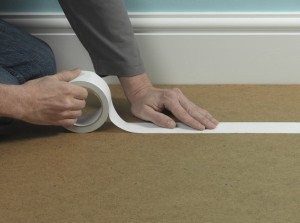 |
1. Unroll and stick a length of double-sided tape adjacent to the starting line. Unless the manufacturer specifies otherwise, you can also tape every third row to hold the tiles securely in place. |
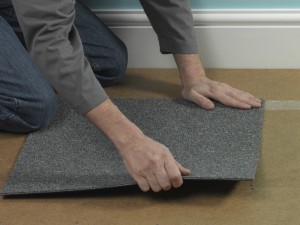 |
2. Take off the tape backing on the double-sided tape and start positioning the first row of tiles. Butt tile edges tightly up against each other. |
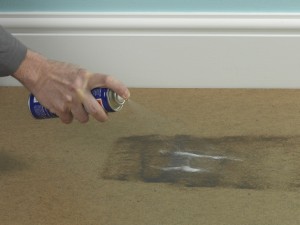 |
3. As an alternative you can use a spray adhesive to hold the tiles in place. Make sure that you use a spray that is recommended for your tiles. Also, wear a mask and keep the room well ventilated. |
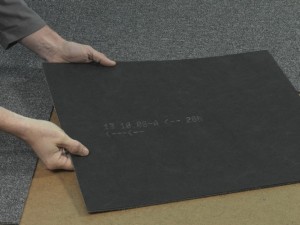 |
4. The direction in which you lay the tiles will affect the pile pattern you achieve. Check directional arrows on the back of the tiles before laying. |
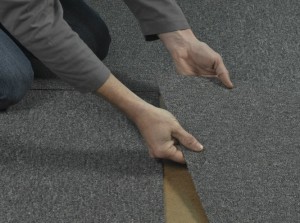 |
5. Build up rows working across the floor. Keep checking that edges are firmly butted up against each other, remembering to lay tape every third row if required. |
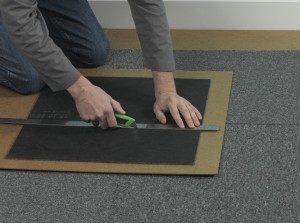 |
6. Around the edge, fill in with cut tiles. Measure accurately, and cut using a craft knife and straight edge. |
Carpet tile tips
- For more information, check the post ‘Laying vinyl tiles’ as this provides further advice on cutting awkward shapes and finishing off with ‘soft’ tiles.
- There are alternatives to the grid design shown here. You can stagger joins to create a brick bond design, or consider going diagonally across the room for a diamond effect pattern. Whichever design you choose, the tiles are laid in the same way – just adjust the start position accordingly.
- Leave tiles in the room they are to be laid in for at least 24 hours to acclimatise to conditions before you lay them.

I believe that carpet tile is a superior floor covering product for many applications such as home offices, basements, home theater, playrooms, and child bedrooms. Modern carpet tile certainly works as a fashion statement in the most formal settings. Really, most any floor where durability, ease of installation and the accent of aesthetic diversity is desired will benefit from carpet tile. Thanks for sharing your explicitly informative article.